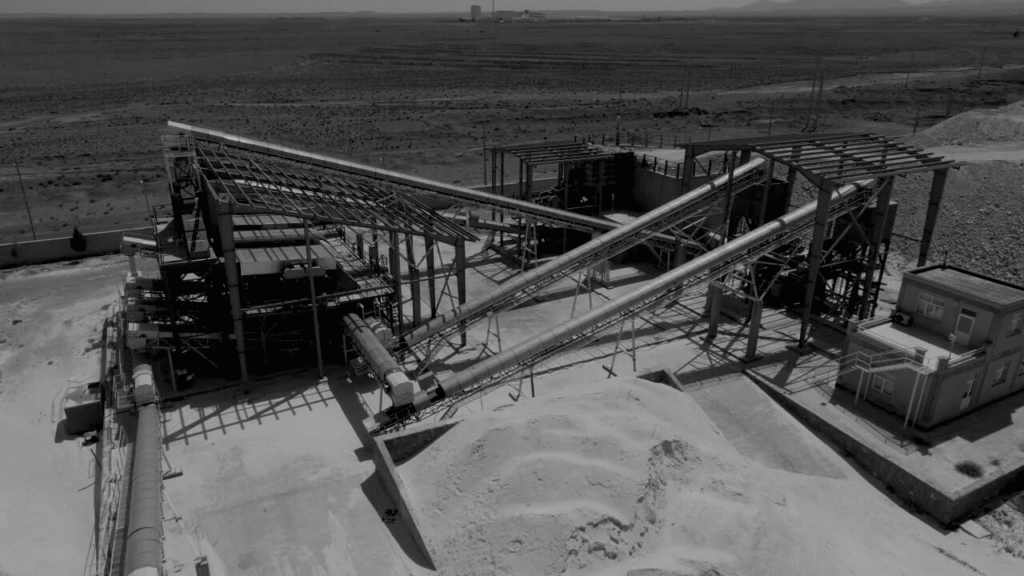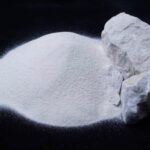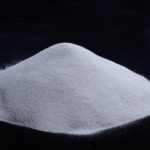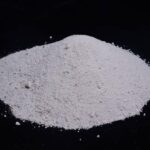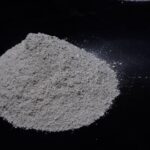Silica (SiO₂) – Overview and Industrial Applications
Introduction to Silica
Silica, also known as silicon dioxide (SiO₂), is the most abundant oxide compound in the Earth’s crust. This white or colorless mineral is predominantly found as quartz (transparent crystals) and constitutes a major part of coastal sands. Silica is a durable insulating material and a key component in the production of glass and electronic semiconductors. In general, silica exists as silicon oxide in various mineral forms, including quartz, flint, and silica gel.
Types of Silica
Silica occurs in two main forms: crystalline and amorphous. The most common crystalline form is quartz, which has a regular, hard structure (Mohs hardness: 7). Other crystalline varieties include chert, flint, and polymorphs like cristobalite and tridymite, which are stable under different pressures and temperatures. Amorphous silica, such as fused glass, silica gel, and microsilica, has an irregular and porous structure. For example, silica gel has a three-dimensional porous framework with nanometer-sized pores. Industrial silica powders and fumed silica (silica smoke) are also fine amorphous forms, often produced through chemical processing of silicates.
Physical and Chemical Properties of Silica
Chemical Formula & Appearance: SiO₂, typically white or colorless solid (glassy).
Molecular Weight & Density: ~60.1 g/mol; density ~2.65 g/cm³.
Melting & Boiling Points: High melting point (~1650–1710°C) and boiling point (>2200°C).
Hardness & Strength: Crystalline quartz has Mohs hardness 7; amorphous silica is slightly softer. All forms are electrically insulating and transparent or white in pure form.
Chemical Stability: Insoluble in water and most common acids; only hydrofluoric acid (HF) dissolves silica. Its chemical stability makes it suitable for corrosion-resistant applications.
Solubility: Very low in water (~0.012 g/100 mL); under extreme conditions (high temperature, high alkalinity), it can form soluble silicates.
Industrial Applications of Silica
Silica’s unique physical and chemical properties make it essential in many industries:
Glass Manufacturing: The largest consumer of silica; provides silicon for construction, automotive, and electronic glass.
Foundry: Used as casting sand for metal molds, especially for steel and aluminum.
Ceramics: In tile, porcelain, and glaze production, silica improves hardness and durability.
Oil & Gas: High-purity silica is used in hydraulic fracturing to support rock cavities and reservoirs.
Water Filtration: Graded silica is used in water filtration systems as an effective and economical filter medium.
Electronics & Semiconductors: Ultra-pure silica (silica gel, fused silica) is essential for chips and photovoltaic cells.
Other Industries: Used in paints (as filler and opacifier), rubber and plastics (as filler), adhesives, refractory materials, and cement.
Importance of Purity and Particle Size
Silica Purity: The SiO₂ content directly affects performance. Higher purity results in fewer impurities and better quality. Ultra-pure silica (≥99.9% SiO₂) is highly demanded in sensitive industries like electronics and glassmaking.
Particle Size Distribution (PSD): Particle size and uniformity affect surface properties and performance. Well-graded silica optimizes water flow in filters and improves adhesion in molding industries. Smaller particles provide higher surface area, enhancing chemical reactions (e.g., silicate production in petrochemicals). Controlling PSD according to industry requirements increases efficiency and reduces waste.
Silica Processing Methods
Silica undergoes multiple extraction and refinement steps to achieve desired purity and PSD:
Extraction: Open-pit silica mines are the primary source, using blasting or excavators.
Crushing: Rocks are crushed using jaw, cone, or vertical shaft crushers for further processing.
Washing & Impurity Removal: Particles are washed to remove clay and fines. Magnetic or density separation removes iron impurities, increasing chemical purity.
Sizing: Sieving separates particles into uniform grades, critical for applications like fine glass sand.
Drying & Calcination (Optional): For amorphous silica or microsilica, drying and high-temperature treatment may be applied, e.g., fumed silica production via evaporation and redeposition.
Chemical Processing (Optional): In some cases, extremely pure or amorphous silica is produced via chemical reactions, such as precipitated silica from sodium silicate and mineral acids or hydrolysis to form silica gel.
Supplying High-Quality Silica for Industry
Key factors for reliable silica supply include:
Reputable Mines: Mines in Iran (e.g., Hamedan, Malayer, Garmsar) ensure high-purity extraction.
Purity Control & Testing: Producers provide chemical and physical analyses (atomic absorption, XRD, viscosity) to guarantee quality (SiO₂ 95–99.9%).
Advanced Processing: Modern equipment ensures consistent particle size and quality.
Standards Compliance: ISO 9001 and industry-specific certifications ensure product reliability for sensitive applications.
Silica Market Overview: Iran & Global
Global Market: Estimated at $49.12 billion in 2022, with a CAGR of ~10% to mid-2030s; annual consumption ~120 million tons. China is the largest producer and consumer. Supply-demand dynamics affect pricing: lower supply increases prices, while abundant supply stabilizes the market.
Iran Market: Iran has ~70 million tons of proven silica reserves in 280 mines, mainly in Hamedan, Semnan, Malayer, and Isfahan. Iran holds ~2% of global reserves and has potential to become a production and export hub. Domestic market projected to reach ~$1.2 billion by 2030 (8% annual growth). Key domestic uses: glass (45%), foundry (25%), electronics/semiconductors (10%), refractory (10%). Major exports go to Iraq, Turkey, UAE, and parts of Europe.
Parskansar Kaniyar leverages an extensive distribution network and is ready to collaborate with domestic and international industries for the supply of silica and other minerals.
FAQs
What is Silica and What is it Used For?
Silica, or silicon dioxide (SiO₂), is the most abundant silicon oxide in the Earth’s crust. It is typically found as crystalline quartz or silica sand. Silica has a wide range of important industrial applications, including glass manufacturing, ceramics, foundry casting, filtration, and electronics.
For example, silica sand serves as the primary source of silicon in both construction and industrial glass production. In the oil industry, graded silica is used as an additive to support the structural integrity of boreholes during drilling.
Difference Between Crystalline (Quartz) and Amorphous Silica
Crystalline silica has an ordered, regular structure; the most well-known form is quartz, which is hard and transparent. In contrast, amorphous (non-crystalline) silica, such as fused glass or silica gel, has a disordered, often porous structure.
In terms of properties, crystalline silica is generally harder and more durable (hardness ~7 on the Mohs scale), whereas amorphous silica can be softer and, in some cases, chemically more reactive (e.g., water absorption).
Why is Silica Purity Important?
Purity refers to the percentage of pure silica (SiO₂) in a sample. The higher the purity (i.e., the fewer the impurities), the better the quality of the material, which increases its demand across industries.
In other words, higher-purity silica (e.g., ≥99.9%) has fewer impurities and more desirable properties for sensitive applications. Lower-purity silica may be suitable for general uses such as foundry sand or road surfacing, but its applicability in advanced industries is limited.
Why is Silica Particle Size Important in Industrial Applications?
The particle size (gradation) of silica plays a crucial role in its performance. For example, in sand filters, a specific particle size ensures uniform water flow and effective removal of suspended solids. In glass production, excessively large grains can compromise clarity. Finer particles provide a larger surface area, improving performance in chemical reactions or as additives in concrete.
In summary, selecting the appropriate particle size according to industry requirements (e.g., medium-sized grains for filtration or specific gradation for casting) optimizes the final product’s performance.
What is the Best Method to Obtain High-Quality Silica for Factories?
The first step is to select a reliable supplier or mine whose laboratory reports on SiO₂ purity can be trusted. The factory should use silica-rich feedstock (pure quartz) and employ advanced technologies for crushing, washing, and screening. Quality assessment includes precise chemical analysis (determining SiO₂ content and impurities) and physical analysis (particle size distribution and hardness). Reputable producers, such as companies in Hamedan and Malayer, follow these steps to produce high-quality, standard silica.
Silica Market Status in Iran and Worldwide
The global silica market has been growing in recent years. Its value was approximately $49 billion in 2022, and it is projected to increase at an annual rate of nearly 10%. Global consumption is estimated at over 120 million tons per year, with China being the largest producer worldwide.
In Iran, silica also plays an important role. The country holds about 2% of global reserves (~70 million tons). The domestic market is expected to reach $1.2 billion by 2030, with exports flowing to neighboring countries. The major domestic consumers are:
Glass industry: 45%
Foundry (casting) industry: 25%
Electronics and refractory industries: 10% each
These figures indicate that, due to abundant resources and rising global demand, Iran has the potential to become a key hub for silica production and trade in the future.


